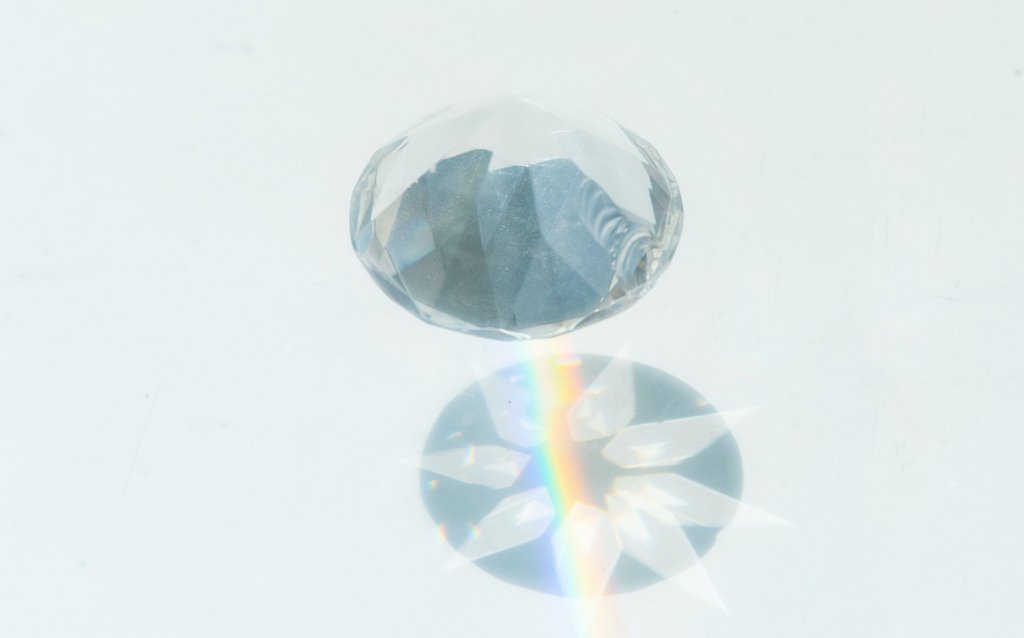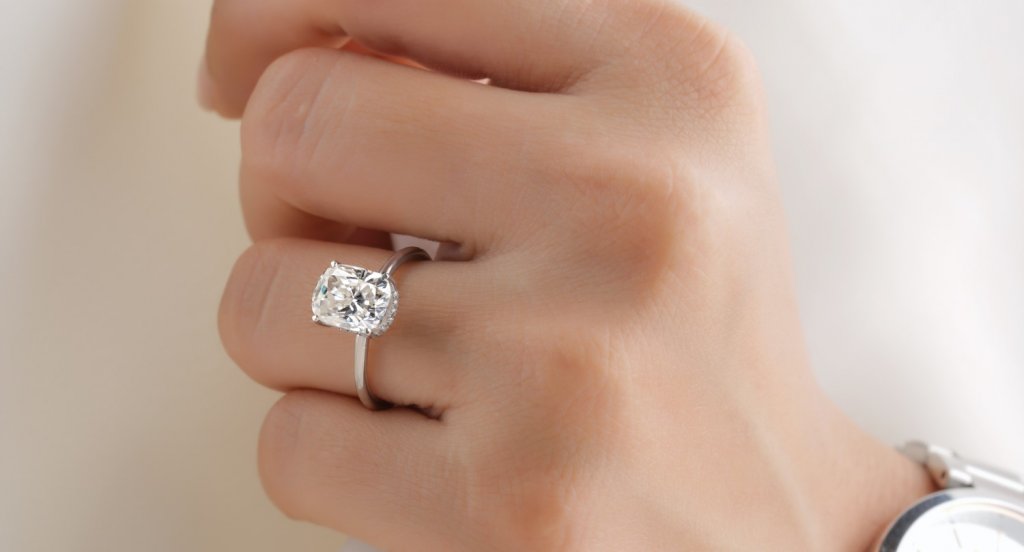Score a Bigger Bling for Your Buck: Shop for Spready Diamonds!
Key Takeaways
- While different diamond shapes naturally feature different weight distribution – meaning some shapes just look bigger than others, even at the same carat weight – it’s not a good idea to get caught up on taking advantage of the apparent size differences between diamonds of the same shape and carat weight.
- Spready diamonds may look a lot bigger than their well-proportioned counterparts, but it’s important to keep in mind that size is only one part of a much larger equation.
- Large diamonds are impressive, but not if they’re missing all the sparkle and brightness that diamonds are loved for. It’s not worth the sacrifice.

Many first-time shoppers start off focused on the size of their ideal diamond, rather than its weight. It’s understandable, given that a diamond’s size is something we will notice instantaneously, whereas its weight is something that will only be ‘found out’ when its dropped into conversation.
This is why, for many people, getting used to the carat system takes a little time. They want to find a diamond that is about this big, or that big, rather than a diamond with a specific carat weight.
The thing is, as you start to learn more about diamonds, you realize that finding a big diamond – or, more specifically, finding a big diamond that is worth your money – means tempering carat weight with diamond proportion, rather than focusing on one or the other.
If not, you could end up with a spready diamond – something that no shopper wants.
What They Are
While you’ve probably heard of the phrase ‘spreading yourself too thin’, you might not have heard the same concept applied to diamonds – but, unfortunately, it’s relatively common, and something you’ll want to look out for.
What is a ‘Spready’ Diamond?
A spready diamond is one that has been shallow cut. From the side, the pavilion will look significantly shorter and ‘squatter’ than you would expect it to. From above, however, the diamond will look a lot larger than other diamonds of the same carat weight.
This is down to weight distribution, and the fact that the diamond cutter distributed far too much of the diamond’s weight into its table and crown, and not enough into the lower portion – the pavilion.
The upper surface of the diamond is considerably wider than it is on a well-proportioned diamond, meaning that, from the side view, its weight appears to be spread outwards rather than evenly distributed throughout the stone’s shape.
Do Spread Diamonds Look Bigger?
Yes and no. From certain angles, you’ll experience the illusion of a diamond with a much higher carat weight but, from others, the illusion will be broken.
It is true that diamonds, once set within engagement rings, are only ever going to be viewed from above – or, at least, 99% of the time, anyway.
This fact alone means that some shoppers will be tempted to invest in a spread diamond, since it’s unlikely that anyone will pick up on the fact that is has been cut out of proportion.
However, there is a lot more to spread diamonds than a squat side-view….
What Happens When a Diamond is Too Shallow?
Light cannot be refracted through the center of the diamond in the way it’s supposed to, meaning that shallow cut diamonds appear significantly less sparkly than others that have been cut to ideal proportions.
The main purpose of the diamond’s pavilion is to reflect light through the center of the stone, and then direct it back through the crown. This is why it needs to be cut at a very specific angle – one which allows as much of the light that enters the diamond to leave it via the crown and table as possible. Otherwise, the light is lost through the pavilion and, as a result, wasted.
In other words, the light being converted into brilliance and fire across the surface of the diamond is significantly limited, leading to a dull stone lacking in the electrifying sparkle for which diamonds are famed.
This is the exact issue suffered by shallow cut diamonds: the angle created by the pavilion is totally wrong, and a lot of the light being reflected through the center of the stone is lost before it can be emitted in mesmerizing flashes of white and colored light.
Consider the Round Brilliant – the shape that is famed throughout the diamond world for its ability to produce more brilliance, fire, and scintillation than any other diamond shape out there. Every slight movement leads to an eruption of light unmatched by any other gemstone, all as a result of the incredible symmetry, precise angles, 57 intricate facets – not to mention the unique structure of diamond.
It is entirely possible – and all too common – for a shallow cut Round Brilliant diamond to prove totally underwhelming. Sure, you’ll get some sparkle out of it, but compare it with a well-proportioned stone of the same weight and you’ll finally get to experience why this cut is more popular than any other.
Why Are Some Diamonds Spready?
For the simple reason that they look bigger, and far more impressive – that is, until the light hits them. While some diamonds are specifically cut to produce the highest quality diamond possible, others are intentionally cut ‘wrong’ to preserve as much of the original stone as possible, and fetch a high price for their carat weight alone.
It’s a fact of life by this point that many, many shoppers want to get the biggest diamond possible. Going beyond the status quo and splashing out on a veritable rock of a diamond has an undeniable prestige about it. It’s a trend set by celebrities – and one that’s been encouraging us to ‘go big or go home’ for almost a hundred years.
And why not? The bigger the diamond, the easier it is to appreciate its beauty – and the harder it is to miss.
The only trouble is that larger diamonds cost considerably more than those of a more modest size. Pushing beyond 1 carat can quickly push shoppers into double figures and, for some, fitting that within their budget just isn’t possible.
This is why there will always be a market for shallow cut diamonds. At face value, a 1 carat spread diamond will appear to be much larger than the rest, and may even impress some onlookers.
The trouble is that most shoppers wind up disappointed sooner or later. While their intentions were in the right place, a diamond’s ability to make an impact lies in its sparkle and beauty just as much as it does its size – if not more.
Diamonds that don’t produce their distinctive sparkle can even look more like cheaper gemstones used to imitate diamond, like cubic zirconia. It’s one thing knowing that your diamond is real, but another thing entirely making sure it looks real – and this is a major pitfall many uninformed shoppers can fall into.
How to Avoid Spready Diamonds
So, you know what they are – you even know exactly why you don’t want to end up with one. But how can you be sure that the diamond you bring home is full of life and sparkle? Working with a good jeweler is key here, as they’re not going to steer you in the wrong direction, but understanding how to objectively judge the dimensions of your diamond is important too.
How Do You know if a Diamond is Spread?
The diamond’s GIA report will contain detailed information on its cut proportions, and learning how to interpret these will prove invaluable to you during your search.
Of course, any good jeweler will walk you through the specifics of any diamond you’re considering before you commit but, even then, it’s helpful to know what those numbers and phrases printed in the GIA report mean.
As one of the Four Cs, cut is given a grade of its own. We would only ever recommend our readers invest in Excellent or Very Good diamonds, as Good, Fair and Poor cuts can all too easily impact the diamond’s beauty.
Beyond that grade, however, you’ll find individual grades for polish and symmetry, and a diagram featuring grades for the girdle and culet, as well as depth and table proportions.
Each diamond shape has an ideal depth proportion. There’s no use in using measurements, since even a small increase or decrease in carat weight will mean different measurements are required. Percentage ranges, however, remain the same whatever carat weight your chosen diamond is.
Are Spready Diamonds More Expensive?
No. Diamonds cut to idea proportions will be more expensive than diamonds that have been cut too shallow or too deep, since either extreme will have a negative impact on light performance.
Our Summary: Is a Spread Diamond Bad?
Yes, and you should run as fast as you can from any jeweler who attempts to talk you into the so called ‘benefits’ of spread diamonds.
There’s no getting around the fact that one of the reasons we care so much about engagement rings is because they represent a unique opportunity to impress. For the most part, we buy them to impress our partners – but also to impress our friends, family, and anyone else we encounter. It’s no secret that diamonds are incredibly valuable, which means that it’s not difficult to make a pretty sizeable impact on anyone’s estimation, whether you opt for 1 carat or 3.
But, understandably, the temptation to push the boat out as far as possible and find a diamond that surpasses all expectations is something most of us will experience at some point during our searches.
Unfortunately, the most ‘affordable’ route lies in the illusion offered by spread diamonds, and plenty of shoppers have fallen for it in the past – and plenty more will fall for it in the future.
The trouble is, beyond the initial ‘wow factor’ of a diamond with a substantial face-up appearance, spready diamonds offer very little value. The real value of an engagement ring lies in its magical sparkle, its innate beauty, and the skill of its cut – three factors that create a far more enviable piece than a diamond cut for size, rather than substance.

Sep 18, 2021 By Willyou.net
This Diamond Cut Outsparkle The Rest – An Insider’S Guide

Mar 26, 2022 By Willyou.net
Key Information About Diamond Girdles








